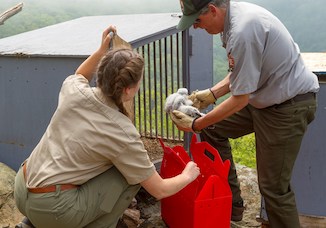
By Randy Arrington
LURAY — This summer a unique and important conservation effort spanning nearly four decades will continue to restore the peregrine falcon population in Shenandoah National Park and the surrounding Appalachian mountains.
Just after Memorial Day, wildlife biologists and partner agencies will relocate five to seven young peregrines, or fledglings, from the coastal region of Virginia to high cliffs in the Shenandoah overlooking the Page Valley.
“Historically peregrine falcons were found in southern Appalachia,” said SNP wildlife biologist Rolf Gubler. “That was their stronghold before DDT… not so much in the coastal plains.”
Pesticides containing DDT were used to dust crops for many years before their harmful effects were discovered and banned with the creation of the Environmental Protection Agency and the environmental laws it enforces.
In the years prior to environmental protections, some birds were harmed through DDT-laden insects they consumed. For peregrine falcons, an apex raptor, it was fish. Chemicals that washed into waterways contaminated the fish, which killed the birds of prey.
In 1980, peregrine falcons nested successfully in Virginia for the first time since DDT depleted their populations. When sporadic restoration efforts in the mountains were lagging in the 1990s, it resumed on an annual basis in 2000. In the last 19 years, 157 falcons have been relocated to Shenandoah National Park.
While there are examples of other wildlife restoration efforts across the country — such as condors in the Grand Canyon, or wolves at Yellowstone — the peregrine falcon program is unique, especially at Shenandoah.
“In terms of restoration in the park, there really isn’t any… it is pretty rare,” Gubler said. “We generally have a hands-off approach and let nature take its course.
“This program, however, serves a dual purpose,” the biologist continued. “We are bringing in birds that would ordinarily die and bringing them to an area where they continue to be lagging in numbers.”
The annual restoration program in Shenandoah National Park that began in 2000 was coordinated through an agreement and partnership with the Center for Conservation Biology at the College of William and Mary, the Virginia Department of Game and Inland Fisheries, and the Virginia Department of Transportation.
Since the peregrine falcon restoration program began four decades ago, more success has been seen in coastal areas than in the mountains. There are several factors driving this, according to Gubler. For one, the program initially focused more on coastal areas and introduced more birds there. Secondly, there is more artificial habitat in coastal areas, such as buildings and bridges that are near or over water. And lastly, a key factor is that coastal areas offer year-round hunting and more prey, as where the mountains have less prey and tougher winters.
SNP biologists are hoping for another successful hacking year like last summer when six birds were released locally. Hacking is the relocation process in which young fledglings are taken from one site to another in wooden boxes called “hacks” that allow them to acclimate to their new environment before being released. In late spring, fledglings from two bridge nesting sites in the Tidewater area will be removed through coordination with VDOT. Once in Shenandoah, they will be kept in hacks on cliffs near Big Meadows for about 10 days.
The hacks serve as protection from predators, such as raccoons. Park staff will feed and monitor the birds, while they mature into their new surroundings. And while some lucky visitors may get a peek at the small birds in the hack, wildlife biologists said that human contact must be limited for the falcons to properly return to the wild.
Once the falcons are released, park staff continues to monitor and feed them from the hack site as they learn how to hunt for themselves. Gubler says the birds remain in the area for several weeks, and then by late July will begin to take extended practice flights of more than 200 miles away. By late August, they are expected to leave the area and wander into other states, eventually migrating south or east as fall approaches.
“Every falcon being reintroduced has a colored band placed on it, and we receive sightings from a variety of other agencies and enthusiasts,” Gubler said. “There is no GPS, so they have been spotted visually in areas like D.C., Harrisburg, Pa., Pittsburg, West Virginia, New York, New Jersey…”
Research from the early 2000s conducted through the Center for Conservation Biology and Falcon Trak Project Partners shows that the reintroduced falcons disperse to areas as far away as Florida, Cuba, the Bahamas and even further south.
Conservationists hope that the falcons released in Shenandoah will “imprint” on the prominent cliffs in the park and return as breeding adults in two to three years to help restore numbers in the mountains. Shenandoah supported nesting pairs from 1994-1997, 2005-2007 and 2009-2014. During that time, these pairs had a 62 percent breeding success rate. The U.S. Forest and Wildlife Service has a recovery goal of 21 breeding pairs in the central and southern Appalachians.
In 1999, peregrine falcons were removed from the Endangered Species List due to successful breeding in eastern coastal and urban areas. However, the birds of prey remain listed as threatened in Virginia under the Commonwealth’s Endangered Species Act.
“We’ve evolved at Shenandoah to have more of a state and regional [peregrine falcon restoration] program” Gubler said. “These birds have been a poster child for a lot of conservation efforts. They are important in keeping a balance in nature, and they are truly beautiful to see flying over.”



Be the first to comment